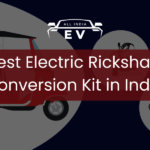Everything you need to know about EV Retrofitting in India
India began using compressed natural gas (CNG) more than two decades ago to lessen its reliance on fossil fuels like gasoline and diesel and to minimize air pollution. The Supreme Court’s ruling in 1998 prompted the widespread conversion of conventional vehicles such as buses, taxis, and three-wheelers to CNG-powered vehicles. As a result, the market for CNG retrofitting was opened up. In this article we have tried to present all information you need to know about EV retrofitting in India.
Today, CNG vehicles are giving way to vehicles driven by electrical batteries, resulting in an increase in the EV retrofitting market.
The process of converting a combustion engine car to an electric vehicle is known as retrofitting, and it represents an untapped opportunity for India because electric vehicle production in India will take its fare share of time to scale.
Although interest in electric vehicles has grown in recent months following the Covid-19 outbreak, it will take several years for these vehicles to have a significant influence on the market.
Imported components, particularly batteries, enhance the cost of electric vehicles and serve as a deterrent to consumers who want to switch to cleaner transportation.
Given the high import duty, the only way to adopt electric vehicles in India is to manufacture them there. The launch of new vehicles in India often takes 4-5 years, especially for low-demand vehicles like freight vehicles or even cars, and unless there is a large demand, the viability of manufacturing vehicles in India will not be as big as it is for ICE vehicles.
This places India in a unique position where it may be feasible to refit old ICE vehicles or to take new vehicle chassis and retrofit them with electric batteries. That is the approach we follow when it comes to retrofitting.
What do you need in EV Retrofitting?
- Motor
- Controller
- Shunt
- Transmission adapter kit
- Charger
- Chill plate
- DC/DC converter
- Throttle controller
- Controller mount
Retrofitting is a big market
According to an analysis by the Ola Mobility Institute, central government e-mobility targets for 2030 can only be met if incentives go beyond the purchase cost of electric vehicles.
The direct and indirect costs of purchasing, operating, and maintaining an electric vehicle are included in the Total Cost of Ownership. With these costs, the cost of ownership for electric vehicles is very high at present, and lack of ev charging infrastructure is cherry on the top.
That is why various firms have sprung up to capitalize on the retrofitting trend.
List of companies doing EV retrofitting
GoGoA1 which is a Mumbai-based EV retrofititng startup, has seen a 60% increase in demand for its retrofitting kits. The company sells India’s first RTO-approved electric motorcycle conversion kit. It specializes not only on OEM/ODM automobiles, and components, but also in electric and solar-powered vehicles and components. By providing hybrid and complete conversion kits, the company primarily focuses on converting existing fuel two-wheelers, three-wheelers, and cars into electric-powered technology.
In March 2022, the business aims to provide conversion kits for further two- and three-wheeler models, followed by four-wheelers and commercial vehicles in the following fiscal year.
Types of test approved by ARAI for EV Retrofitting
ARAI regulates type tests AlS123 – Part 1, Part 2, and Part 3 to certify EV retrofitting kits.
There are two steps in the type approval procedure:
Kit component level approval: All component aggregates being added to the vehicle, including traction motor, battery, and inverter, must be approved at the kit component level. For conversion into a hybrid ev or pure EV, wire harnesses, connections, status of charge indicators, and any additional electronics such as vehicle control units and onboard chargers must first be certified as a kit.
Vehicle level approval: The applicant must submit to ARAI for Type approval a refitted electric vehicle that is currently in operation.
The Type Approval certificate for the vehicle is approved if both types of tests are completed satisfactorily. The kit producer can then appoint dealers to sell the kits for that specific car. On behalf of the kit manufacturer, the dealer can refit.
Advantages of EV Retrofitting
- Reduced operational cost of vehicle
- Require less maintenance
- No excessive noise and vibration
- Good for nature
Disadvantage of EV Retrofitting
- Cost of battery is high and you need to change battery after every 4-5 years
- High initial cost
Now we believe you have answers to all of your question related to the EV Retrofitting in India. If you have any information which we missed then please share the same with us.





